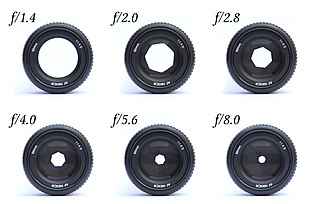
In optics, an aperture is a hole or an opening through which light travels. More specifically, the aperture and focal length of an optical system determine the cone angle of a bundle of rays that come to a focus in the image plane.

Carl Zeiss AG, branded as ZEISS, is a German manufacturer of optical systems and optoelectronics, founded in Jena, Germany in 1846 by optician Carl Zeiss. Together with Ernst Abbe and Otto Schott he laid the foundation for today's multi-national company. The current company emerged from a reunification of Carl Zeiss companies in East and West Germany with a consolidation phase in the 1990s. ZEISS is active in four business segments with approximately equal revenue, Industrial Quality and Research, Medical Technology, Consumer Markets and Semiconductor Manufacturing Technology in almost 50 countries, has 30 production sites and around 25 development sites worldwide.
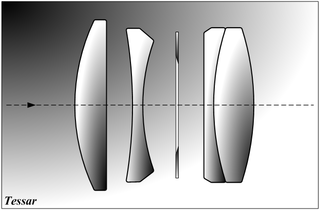
The Tessar is a photographic lens design conceived by the German physicist Paul Rudolph in 1902 while he worked at the Zeiss optical company and patented by Zeiss in Germany; the lens type is usually known as the Zeiss Tessar.

A fisheye lens is an ultra wide-angle lens that produces strong visual distortion intended to create a wide panoramic or hemispherical image. Fisheye lenses achieve extremely wide angles of view. Instead of producing images with straight lines of perspective, fisheye lenses use a special mapping, which gives images a characteristic convex non-rectilinear appearance.
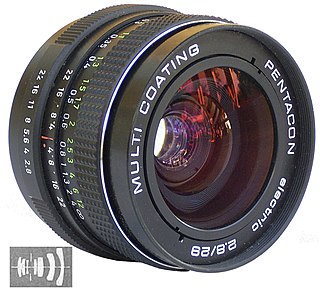
In film and photography, a prime lens is a fixed focal length photographic lens, typically with a maximum aperture from f2.8 to f1.2. The term can also mean the primary lens in a combination lens system. Confusion between these two meanings can occur if context doesn't make the interpretation clear. People sometimes use alternate terms—primary focal length, fixed focal length, or FFL to avoid ambiguity.
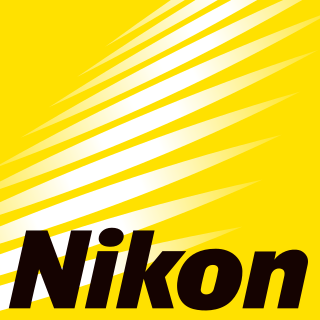
Nikon Corporation, also known just as Nikon, is a Japanese multinational corporation headquartered in Tokyo, Japan, specializing in optics and imaging products. The companies held by Nikon form the Nikon Group.

Macro photography is extreme close-up photography, usually of very small subjects and living organisms like insects, in which the size of the subject in the photograph is greater than life size . By the original definition, a macro photograph is one in which the size of the subject on the negative or image sensor is life size or greater. In some senses, however, it refers to a finished photograph of a subject that is greater than life size.
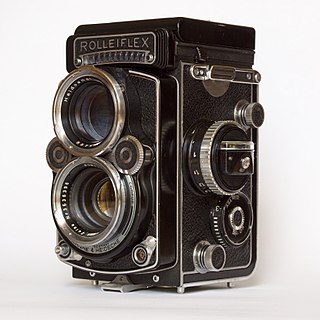
Rolleiflex is the name of a long-running and diverse line of high-end cameras originally made by the German company Franke & Heidecke, and later Rollei-Werke.

Contax began as a camera model in the Zeiss Ikon line in 1932, and later became a brand name. The early cameras were among the finest in the world, typically featuring high quality Zeiss interchangeable lenses. The final products under the Contax name were a line of 35 mm, medium format, and digital cameras engineered and manufactured by Japanese multinational Kyocera, and featuring modern Zeiss optics. In 2005, Kyocera announced that it would no longer produce Contax cameras. The rights to the brand are currently part of Carl Zeiss AG, but no Contax cameras are currently in production, and the brand is considered dormant.

Schneider Kreuznach is the abbreviated name of the company Jos. Schneider Optische Werke GmbH, which is sometimes also simply referred to as Schneider. They are a manufacturer of industrial and photographic optics. The company was founded on 18 January 1913 by Joseph Schneider as Optische Anstalt Jos. Schneider & Co. at Bad Kreuznach in Germany. The company changed its name to Jos. Schneider & Co., Optische Werke, Kreuznach in 1922, and to the current Jos. Schneider Optische Werke GmbH in 1998.

The Nikon F-mount is a type of interchangeable lens mount developed by Nikon for its 35mm format single-lens reflex cameras. The F-mount was first introduced on the Nikon F camera in 1959, and features a three-lug bayonet mount with a 44 mm throat and a flange to focal plane distance of 46.5 mm. The company continues, with the 2020 D6 model, to use variations of the same lens mount specification for its film and digital SLR cameras.

The Pentax K-mount, sometimes referred to as the "PK-mount", is a bayonet lens mount standard for mounting interchangeable photographic lenses to 35 mm single-lens reflex (SLR) cameras. It was created by Pentax in 1975, and has since been used by all Pentax 35 mm and digital SLRs and also the MILC Pentax K-01. A number of other manufacturers have also produced many K-mount lenses and K-mount cameras.

Tilt–shift photography is the use of camera movements that change the orientation or position of the lens with respect to the film or image sensor on cameras.
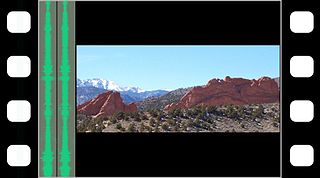
Anamorphic format is the cinematography technique of shooting a widescreen picture on standard 35 mm film or other visual recording media with a non-widescreen native aspect ratio. It also refers to the projection format in which a distorted image is "stretched" by an anamorphic projection lens to recreate the original aspect ratio on the viewing screen. The word anamorphic and its derivatives stem from the Greek anamorphoun, compound of morphé with the prefix aná. In the late 1990s and 2000s, anamorphic lost popularity in comparison to "flat" formats such as Super 35 with the advent of digital intermediates; however in the years since digital cinema cameras and projectors have become commonplace, anamorphic has experienced a considerable resurgence of popularity, due in large part to the higher base ISO sensitivity of digital sensors, which facilitates shooting at smaller apertures.
The Canon TS-E 24 mm f/3.5L II is a tilt-shift, wide-angle prime lens that provides the equivalent of the corresponding view camera front movements on Canon EOS camera bodies. Though it uses Canon's EF lens mount, it does not provide autofocus.

The Canon TS-E 45 mm f/2.8 is a tilt-shift, normal prime lens that provides the equivalent of the corresponding view camera front movements on Canon EOS camera bodies. Unlike most other EF-mount lenses, it does not provide autofocus.
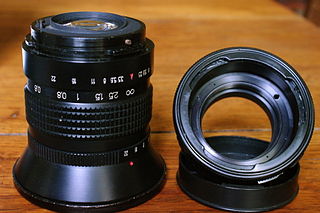
The Pentacon Six mount is a breech-lock bayonet lens mount originally used by several medium format single-lens reflex cameras from East Germany.

The E-mount is a lens mount designed by Sony for their NEX and ILCE series of camcorders and mirrorless cameras. The E-mount supplements Sony's A-mount, allowing the company to develop more compact imaging devices while maintaining compatibility with 35mm sensors. E-mount achieves this by:

The Nikon PC-E Nikkor 24mm f/3.5D ED Lens is a tilt-shift, wide-angle prime lens that provides the equivalent of the corresponding view camera front movements on Nikon F-mount camera bodies. Its ultra-wide perspective control features tilt, shift and rotation capability, well-suited for architectural and nature photography.
The Canon TS-E 50 mm f/2.8L MACRO is a tilt-shift prime lens that provides the equivalent of the corresponding view camera front movements on Canon EOS camera bodies. Unlike most other EF-mount lenses, it does not provide autofocus.



















